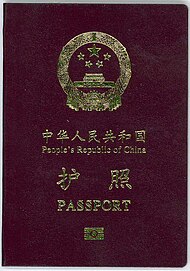
Back جواز سفر صيني Arabic Čínský cestovní pas Czech Pasaporte chino Spanish Hiina Rahvavabariigi pass Estonian گذرنامه چینی Persian Passeport chinois French Putovnica Narodne Republike Kine Croatian Paspor Tiongkok ID 中華人民共和国旅券 Japanese Passaport cines LMO
| People's Republic of China passport 中华人民共和国护照 | |
|---|---|
 Front cover of the current Chinese passport (with chip | |
 Personal data page of the current Chinese biometric passport | |
| Type | Passport |
| Issued by | National Immigration Administration |
| First issued | 1949 |
| Purpose | Identification |
| Eligibility | Chinese nationals with Hukou residing in Mainland China, or Chinese nationals residing abroad who do not qualify for travel documents issued by Hong Kong SAR or Macau SAR.[1] Chinese nationals who are permanent residents of Macau or Permanent residents of Hong Kong are eligible for a MSAR passport or HKSAR passport instead. |
| Expiration | 10 years after acquisition for adults aged 16 or over, 5 for children or non-ordinary passport 3 months for single group travel[2] |
| Cost | ¥120 for both first passport and renewed passport |
 |
|---|
|
|
The People's Republic of China passport[a] (commonly referred to as the Chinese passport)[b] is a passport issued to citizens of the People's Republic of China for the purpose of international travel, and entitles its bearer to the protection of China's consular officials overseas.
On 1 July 2011, the Ministry of Foreign Affairs launched a trial issuance of e-passports for individuals conducting public affairs work overseas on behalf of the Chinese government.[3][4] The face, fingerprints, and other biometric features of the passport holder is digitized and stored in pre-installed contactless smart chip,[5][6] along with "the passport owner's name, sex and personal photo as well as the passport's term of validity and [the] digital certificate of the chip".[7] Ordinary biometric passports were introduced by the Ministry of Public Security on 15 May 2012.[8] As of January 2015, all new passports issued by China are biometric e-passports, and non-biometric passports are no longer issued.[7]
In 2012, over 38 million Chinese citizens held ordinary passports, comprising only 2.86 percent of the total population at the time.[9] In 2014, China issued 16 million passports, ranking first in the world, surpassing the United States (14 million) and India (10 million).[10] The number of ordinary passports in circulation rose to 120 million by October 2016, which was approximately 8.7 percent of the population.[11] As of April 2017 to date, China had issued over 100 million biometric ordinary passports.[12]
- ^ Article 13 of the Chinese passport law
- ^ "《中俄边境旅游暂行管理实施细则》". www.aihui.gov.cn (in Simplified Chinese). Archived from the original on 30 October 2020. Retrieved 27 October 2020.
- ^ 中华人民共和国外交部公告 (in Chinese). Ministry of Foreign Affairs of the People's Republic of China. 1 June 2011. Archived from the original on 13 September 2011. Retrieved 31 August 2011.
- ^ "China: Procedure and requirements to obtain a biometric passport,..." Canada. Immigration and Refugee Board. 6 May 2013. Archived from the original on 12 December 2019. Retrieved 12 December 2019 – via UNHCR.
- ^ "Foreign Minister Yang Jiechi Attends the Launch Ceremony for the Trial Issuance of E-Passports for Public Affairs". Ministry of Foreign Affairs. Archived from the original on 5 February 2011. Retrieved 15 February 2011.
- ^ "因公电子护照31日试点签发 可使持照人快速通关". 中国网. Archived from the original on 7 July 2011. Retrieved 15 February 2011.
- ^ a b "Responses to Information Requests: CHN105049.E China: Information on electronic/biometric passports,..." (PDF). Canada. Immigration and Refugee Board. 22 September 2015. Archived (PDF) from the original on 9 October 2021. Retrieved 12 December 2019.
- ^ "Chinese passports to get chipped". China Daily USA. Archived from the original on 21 September 2018. Retrieved 5 May 2012.
- ^ "3800万中国公民持有普通护照 电子护照正式签发启用". Archived from the original on 2016-04-14. Retrieved 2016-03-31.
- ^ "India ranks third in issuing passports". Times of India. Archived from the original on 2016-03-05. Retrieved 2016-03-31.
- ^ "国务院关于出境入境管理法执行情况的报告". Archived from the original on 2016-11-06. Retrieved 2016-11-05.
- ^ "4月全国启用新号段电子普通护照 你拿到新护照了吗 - 爱旅行网". www.ailvxing.com. Archived from the original on 2017-12-01. Retrieved 2017-11-19.
Cite error: There are <ref group=lower-alpha> tags or {{efn}} templates on this page, but the references will not show without a {{reflist|group=lower-alpha}} template or {{notelist}} template (see the help page).